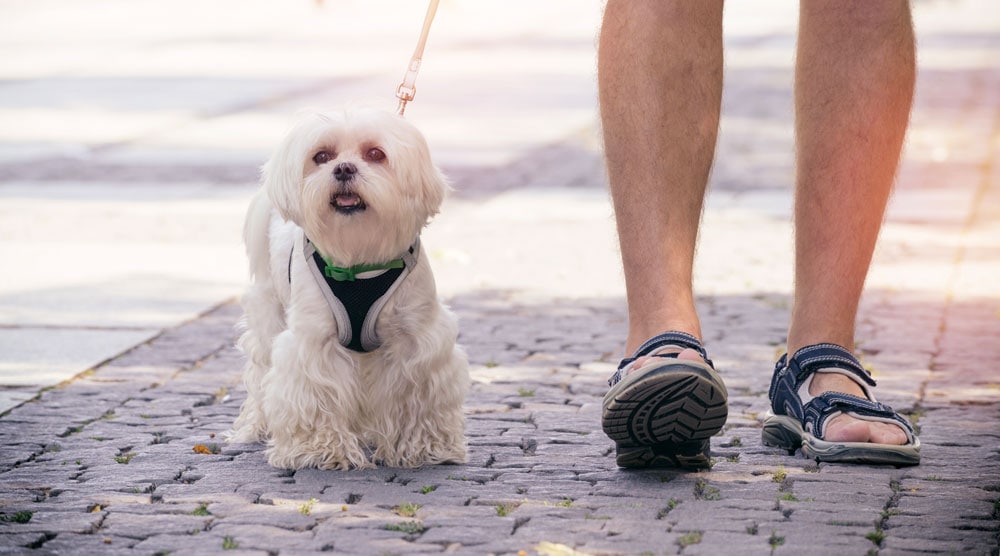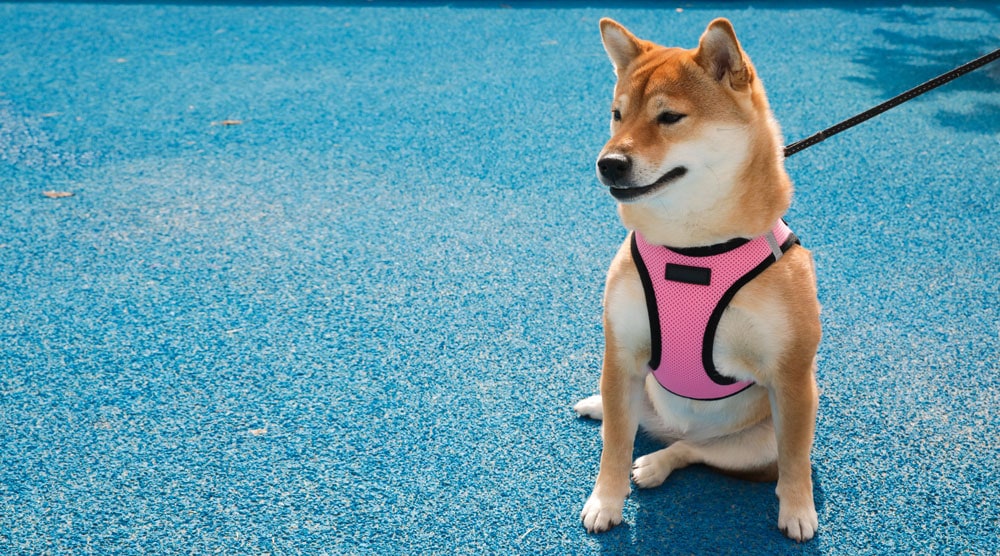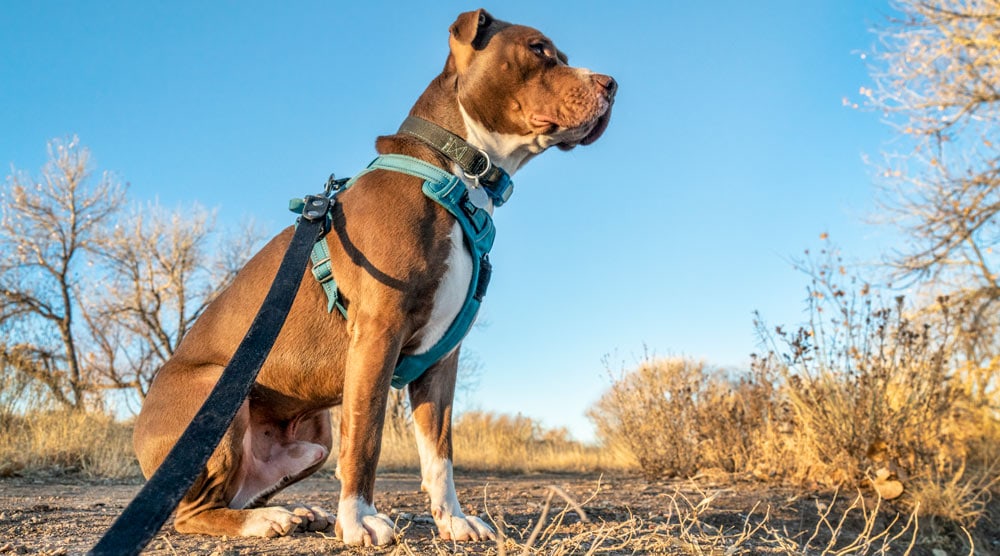Quick Takeaways
- Step-in dog harnesses are worn by placing the dog’s paws between two loops. The harness is then pulled up and buckled over the back.
- The main advantage of step-in harnesses is that they don’t require the harness to be passed over the dog’s head. This is useful for dogs that have a fear of anything going over their head.
- However, the downside is that the dog needs to be physically moved into a step-in harness. This type of handling is invasive and can cause stress.
- For this reason, we only recommend step-in harnesses for dogs with an established fear of objects being passed over their head or touching their ears.
Unlike standard harnesses, step-in dog harnesses don’t need to be passed over the dog’s head. This can be helpful for anxious dogs, although this type of harness has some downsides too.
With the help of IMDT dog trainer Rebecca Morello, this article explains step-in harnesses and how they work. We’ll also discuss the pros and cons of step-in harnesses and how to decide whether they are a good choice for your pet.
Contents
Overview of the Step-In Harness

The term “step-in” refers to how you put the harness on a dog.
Standard harnesses have a gap for the dog’s head to go through. But with a step-in harness, the dog’s legs need to be placed in two loops, before the harness is pulled up and buckled over the back.
The key difference is that you don’t need to pull a sleeve over the dog’s head when using a step-in. There’s also nothing to clip around the neck, which can be disconcerting for nervous pups.
However, there are some downsides to this type of harness, which is why we recommend trying standard harnesses first. Let’s take a closer look at the pros and cons of step-ins.
What Are the Advantages?
For dogs frightened by equipment passing over their heads, step-in harnesses can be a useful alternative to other types of harnesses. If you know that your dog fears anything going over their head, we recommend trying a step-in harness to see if they prefer it.
Of course, step-in harnesses also have the same benefits as other types of harnesses. A key advantage is that harnesses distribute leash pressure across the dog’s chest and shoulders, which protects the trachea. They are also harder for a dog to escape from.
What Are the Disadvantages?
There are several drawbacks to a step-in harness. Firstly, they typically have less padding than other types of harnesses, so there is a higher risk of chafing – particularly under the arms. Make sure you purchase one with plenty of padding, a low neckline, and a proper fit.
Secondly, putting on a step-in harness often requires physical handling of a dog’s paws and legs. Many dogs don’t enjoy this type of handling, so it’s important to be careful and gentle.
“My goal is always to get the dog to cooperate willingly and through choice,” says Rebecca Morello, IMDT dog trainer. “Putting a step-in harness on can be very invasive, as it often involves physically moving the dog or holding them still.”
“For this reason, unless the dog has an established fear of things going over their head or touching their ears, step-in harnesses aren’t my first choice,” says Morello. She adds that step-in harnesses can also be fiddly to put on.
On a side note, we don’t recommend using a head halter for most dogs.

How to Put On a Step-In Harness
Step-in harnesses aren’t difficult to put on a dog, but they can be fiddly. It’s also vital to use positive and kind techniques when teaching your dog to wear this type of harness, as bad experiences can cause long-term harness anxiety.
“If you find a step-in harness works best for you and your pup, make sure it has padding and give yourself plenty of time to it on slowly and calmly,” says Morello. “It’s vital not to force your dog into the step-in harness at the last minute, particularly when they are getting used to wearing it.”
Here’s how to put a step-in harness on a dog using positive methods:
- Start by unbuckling the harness and laying it flat on the ground.
- Using a treat, lure your dog to the harness so that their paws are in the loops.
- Once your dog is in the correct position, let go of the treat so they can eat it while you pull the harness up.
- Pull the straps together and secure the buckle on the dog’s back.
- Adjust the straps so the harness is snug without being too tight. Aim for a fit that allows two fingers to slide between the harness and your dog.
Once you’ve fitted the harness on first use, you shouldn’t need to adjust it for a while. It’s worth checking every few walks, however, as there’s a chance the buckles could come loose.
Note: It’s also essential to get the right size harness. An incorrect size or poor fit can cause chafing, restricted movement, and may even allow your dog to escape. Check out our harness sizing guide here for more information.
Which Brands Make Step-in Harnesses?
The step-in design has become a popular harness type in recent years, so most brands manufacture them. Some examples include Kurgo, Ruffwear, and Chai’s Choice.
There are differences in how step-in harnesses are constructed by the various brands though.
Some harnesses’ are just straps with adjustment buckles. These are often cheap and great for dogs that don’t like a bulky harness, but are less suitable for dogs that are reactive or pull. They are also more likely to chafe or rub.
Other harnesses are designed with wider padded straps. These are more cumbersome for the dog, but do a better job of dissipating force and are more comfortable. The right choice for your pet depends on your dog’s behavior on walks.
Summary
Step-in harnesses can be a great choice for dogs who are fearful of things being passed over their head. However, they have some significant downsides, including that they require your dog to be physically moved into the loops. Many step-in harnesses are also fiddly to put on.
For these reasons, we typically recommend that dog owners try a standard harness first. If your dog hates things going over their head, then a step-in might be a good alternative.
Do you have any questions about step-in harnesses? Let us know in the comments section below. You may also want to read our article about the best harnesses for dogs.




